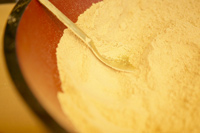
E-Numbers represent specific food additives, used by the food industry in the manufacture
of various food products. These E-Numbers have been formulated by the European Economic
Community (EEC) and are universally adopted by the food industry worldwide.It is
known that many E-numbers contain unlisted haraam ingredients in them. Generally
additives derived from animals and insects. E-numbers are reference numbers used
by the European Union to facilitate identification of food additives. All food additives
used in the European Union are identified by an E-number. The "E" stands for "Europe"
or "European Union". Normally each food additive is assigned a unique number, though
occasionally, related additives are given an extension ("a", "b", or "i", "ii")
to another E-number. The Commission of the European Union assigns e-numbers after
the additive is cleared by the Scientific Committee on Food (SCF), the body responsible
for the safety evaluation of food additives in the European Union. The convention
for assigning E-numbers is:
|
|
100-199
|
food colors
|
|
|
200-299
|
preservatives
|
|
|
300-399
|
antioxidants, phosphates, and complexing agents
|
|
|
400-499
|
thickeners, gelling agents, phosphates, humectants, emulsifiers
|
|
|
500-599
|
salts and related compounds
|
|
|
600-699
|
flavor enhancers
|
|
|
700-899
|
not used for food additives (used for feed additives)
|
|
|
900-999
|
surface coating agents, gases, sweeteners
|
|
|
1000-1399
|
miscellaneous additive
|
|
|
1400-1499
|
starch derivatives
|
E-numbers are only used for substances added directly to food products, so contaminants,
enzymes and processing aids, which may be classified as additives in the USA, are
not included in the E-number system. There is an EU directive on food labeling which
requires food additives to be listed in the product ingredients whenever they are
added for technological purposes. This includes coloring, sweetening and favor enhancement
as well as for preservation, thickening, emulsifying and the like. Ingredients must
be listed in descending order of weight, which means that are generally found close
to the end of the list of ingredients. However, substances used in the protection
of plants and plant products, flavorings and substances added as nutrients (e.g.,
minerals, trace elements or vitamins) do not need to be included in the ingredient
list. Because of this, some substances that are regulated as food additives in other
countries may be exempt from the food additive definition in the EU.